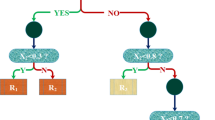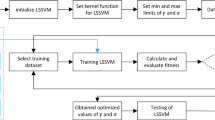Abstract
The goal of this study is to provide a methodology to develop a groutability (N) formula of sandy silt soils using microfine cement grouts in a permeation grouting. Because the Fines Content (FC) of the sandy silt soils studied is relatively high, and the size of the grouts used is significantly smaller than the Portland cement, the existing empirical formulas cannot deliver a promising prediction of N. Support Vector Machines (SVMs) is an alternative tool used to predict N. However, SVMs do not provide an explicit formula, which creates an obstacle for practical engineers. Thus, a heuristic algorithm (the Tabu search, TS) was used to build the prediction formula. A total of 240 in-situ data samples were analyzed to ensure the accuracy of the proposed formula. The format of the existing empirical formula was adopted in the proposed TS-based formula. Four parameters were considered in our TS models: the effective soil particle size (D 10), the soil particle size (D 15), the water-to-cement ratio (w/c) and the FC. The prediction accuracy of the TS-based formula was approximately 94.17%, indicating that the proposed formula is a suitable tool. Because the proposed formula has a similar format to that of formulas that are typically used, the proposed approach can be implemented readily in practical engineering settings. Note that the proposed formula was only verified by the collected data samples, the suitability of applying the built formula to other conditions needs more investigation.
Similar content being viewed by others
References
Akbulut, S. and Saglamer, A. (2002). “Estimating the groutability of granular soils: A new approach.” Tunn. Undergr. Space Technol., Vol. 17, No. 4, pp. 371–380.
Axelsson, M., Gustafson, G., and Fransson, A. (2009). “Stop mechanism for cementitious grouts at different water-to-cement ratio.” Tunn. Undergr. Space Technol., Vol. 24, No. 4, pp. 390–397.
Bahrami, A., Monjezi, M., Goshtasbi, K., and Ghazvinian, A. (2011). “Prediction of rock fragmentation due to blasting using artificial neural network.” En. Comput., Vol. 27, No. 2, pp. 177–181.
Boser, B., Guyon, I., and Vapnik, V. (1992). “An training algorithm for optimal margin classifiers.” Fifth Annual Workshop on Computational Learning Theory, Pittsburgh, ACM, pp. 144–152.
Burwell, E. B. (1985). “Cement and clay grouting of foundations: Practice of the corps of engineering.” J. Soil Mech. Found Div., Vol. 84, No. 1, pp. 1551/1–1551/22.
Cho, S. E. (2009). “Probabilistic stability analyses of slopes using the ANN-based response surface.” Comput. Geotech., Vol. 36, No. 5, pp. 787–797.
Chun, B. S., Lee, Y. J., and Chung, H. I. (2006). “Effectiveness of leakage control after application of permeation grouting to earth fill dam.” KSCE J. Civ. Eng., Vol. 10, No. 6, pp. 405–414.
Das, S. K. and Basudhar, P. K. (2006). “Undrained lateral load capacity of piles in clay using artificial neural network.” Comput. Geotech., Vol. 33, No. 8, pp. 454–459.
Glover, F. (1986). “Future paths for integer programming and links to artificial intelligence.” Comput. Oper. Res., Vol. 13, No. 5, pp. 533–549.
Hillier, F. S. and Lieberman, G. J. (2005). Introduction to operations research, McGraw-Hill, New York.
Huang, C. L., Fan, J. C., and Yang, W. J. (2007). “A study of applying microfine cement grout to sandy silt soil.” Sino-Geotech., Vol. 111, No. 1, pp. 71–82.
Incecik, M. and Ceren, I. (1995). “Cement grouting model tests.” Bull. Tech. Univ. Istanbul, Vol. 48, No. 2, pp. 305–317.
Khandelwal, M. (2011). “Blast-induced ground vibration prediction using support vector machine.” En. Comput., Vol. 27, No. 3, pp. 193–200.
Khayat, K. H., Ballivy, G., and Gaudreault, M. (1997). “High-performance cement grout for underwater crack injection.” Can. J. Civil Eng., Vol. 24, No. 3, pp. 405–418.
Krizek, R. J., Liao, H. J., and Borden, R. H. (1992). “Mechanical properties of microfine cement/sodium silicate grouted sand.” Soil Improv. Geosynth., ASCE Special Technical Publication on Grouting, pp. 688–699.
Kuo, Y. L., Jaksa, M. B., Lyamin, A. V., and Kaggwa, W. S. (2009). “ANN-based model for predicting the bearing capacity of strip footing on multi-layered cohesive soil.” Comput. Geotech., Vol. 36, No. 3, pp. 503–516.
Lee, J. J. and Kim, Y. S. (2010). “Development of advanced pattern recognition model for evaluation of lateral displacement on soft ground using support vector machine.” KSCE J. Civ. Eng., Vol. 14, No. 2, pp. 173–182.
Liao, K. W., Fan, J. C., and Huang, C. L. (2011). “An artificial neural network for groutability prediction of permeation grouting with microfine cement grouts.” Comput. Geotech., Vol. 38, No. 8, pp. 378–386.
Mita, A. and Hagiwara, H. (2003). “Quantitative damage diagnosis of shear structures using support vector machine.” KSCE J. Civ. Eng., Vol. 7, No. 6, pp. 683~689.
Ozgurel, H. G. and Vipulanandan, C. (2005). “Effect of grain size and distribution on permeability and mechanical behavior of acrylamide grouted sand.” J. Geotech. Geoenviron. Eng., Vol. 131, No. 12, pp. 1457–1465.
Perret, S., Khayat, K. H., Gagnon, E., and Rhazi, J. (2002). “Repair of 130-year old masonry bridge using high-performance cement grout.” J. Bridge Eng., Vol. 7, No. 1, pp. 31–38.
Schwarz, L. G. and Krizek, R. J. (2006). “Hydrocarbon residuals and containment in microfine cement grouted sand.” J. Mater. Civil Eng., Vol. 18, No. 2, pp. 214–228.
Tekin, E. and Akbas, S. O. (2011). “Artificial neural networks approach for estimating the groutability of granular soils with cement-basis grouts.” Bull. Eng. Geol. Environ., Vol. 70, No. 1, pp. 153–161.
Tung, C. P. and Chou, C. A. (2002). “Application of tabu search to groundwater parameter zonation.” J. Am. Water Resour., Assoc. Vol. 38, No. 4, pp.1115–1126.
Zebovitz, S., Krizek, R. J., and Atmatzidis, D. K. (1989). “Injection of fine sands with very fine cement grout.” J. Geotech. Eng. Div., Vol. 115, No. 12, pp. 1717–1733.
Author information
Authors and Affiliations
Corresponding author
Rights and permissions
About this article
Cite this article
Huang, CL., Fan, JC., Liao, KW. et al. A methodology to build a groutability formula via a heuristic algorithm. KSCE J Civ Eng 17, 106–116 (2013). https://doi.org/10.1007/s12205-013-1847-y
Received:
Accepted:
Published:
Issue Date:
DOI: https://doi.org/10.1007/s12205-013-1847-y




